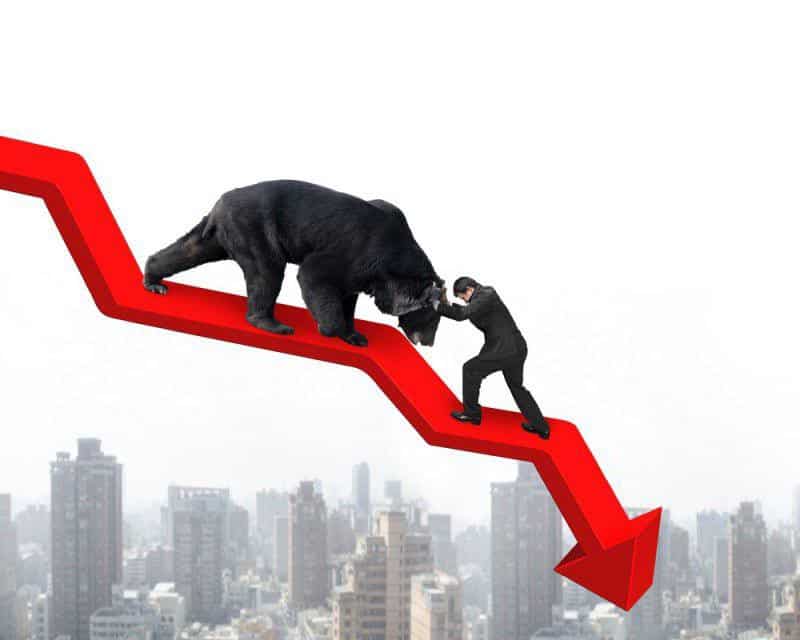
Investors that have been holding on for dear life, held on a bit tighter Monday as the S&P 500 slipped into a bear market, off 20 percent from the highs, and the Dow Jones Industrial Average tumbled more than 600 points, now below 22,000. The declines ahead of the Christmas holiday come after weeks of extreme stock market volatility and amid a renewed attack on the Federal Reserve by President Trump.
Whether you have a 401(k) or plain vanilla retirement account, these can be trying times riddled with uncertainty, but it is not the first time the markets have swooned, and it won’t be the last.
A series of financial advisers weigh in on what is causing the volatility and how to make sense of the moves when viewing your portfolio.
What’s causing the volatility?
Is it just passing or cyclical market volatility, a market correction in response to overvalued equities, overreaction to geopolitical turmoil or the Fed’s plans to raise rates again – or is it likely the start of a more prolonged bear market or even recession?
Michael Canet, the owner of Prostatis Financial Advisors Group, Baltimore, says it’s due to a little bit of all of those things taken together, plus a fading of the euphoria that boosted markets in the wake of the Tax Cuts and Job Acts of 2017, and fears of a trade war with China.
“We are nine and a half years into a bull market – that’s almost unheard of,” Canet says. “We know looking back through the history of tax cuts, all major cuts have been followed within 12 to 18 months by a market correction; the geopolitical aspects of a trade war with China; and rising interest rates constricting easy, cheap money. It all points to at least a correction if not a bear market. It’s time to think defensively and have a strategy in place so that you can avoid another 2008 market crash.”
Rosy or stormy outlook?
Some financial advisers like to project a rosy outlook for obvious reasons, but the best ones balance confidence in their long-term investment philosophy with a clear-eyed assessment of potential risks and pitfalls.
Brent Ford, a registered investment adviser at Benefit Resource Partners of Chippewa Falls, Wisconsin, says that the market through the later part of 2018 has been mixed, but the economy on the whole remains strong, and until that changes significantly, there is reason for optimism.
“Often we hear when we look at the chatter that this is the end of the best years in the market, the climate has shifted, and we are moving to a number of years of limited or negative returns,” Ford says. “However, the data just doesn’t support that conclusion.”
The recent sell-off is being driven by many factors, Ford believes: technology, rising interest rates and the global trade war.
Tech Trouble
“The tech sector stayed relatively healthy in some of the volatility that took place at the beginning part of 2018, that flash crash in February and March,” Ford says. “It is reasonable to see that some of the corrections in that sector of the market were due and we did see that happen starting at the front end of September.”
Since the tech sector is so heavily market weighted both in the S&P 500 (21.4 percent, which is the largest single weight to any sector in that index) and in the Dow (17.9 percent, second only to the industrials sector), when we have normal corrections they can make significant waves when you are exclusively buying the indexes.
“The waves can be even more significant if you are following the companies that are garnering the most popularity such as Amazon, Google and Facebook,” Ford says.
Federal Reserve
The second factor is the Federal Reserve hiking interest rates for the fourth time in 2018. The program of artificially suppressing interest rates to spur economic growth for the U.S. economy has ended and the Federal Reserve now has the complicated task of deciding when and how they are going to increase interest rates without pushing the economy back into recession in 2019.
The Fed’s path of interest rate hikes in 2018 has irked President Trump who has publically blasted policymakers numerous times, even going as far as to reportedly consider axing Fed Chair Jerome Powell, as first reported by Bloomberg.
“This policy is not only unpopular with Wall Street, it does have an effect on consumers,” Ford says. “We have not seen the severe effects of interest rate policy hit yet, but the Fed knows we are on a very high-stakes teeter-totter – if they increase too soon, the market could correct, but if we don’t at all, inflation will rear its ugly head.”
Another effect that interest rates have on the economy is the downward pressure on bond prices. Interest rates and bond prices have a negative correlation, so when interest rates increase, bond prices decrease.
“This can be problematic in an equity market that is experiencing some increased volatility and there is no safe haven for a conservative investor to go,” Ford says. “Interest rates may become the most important economic policy going forward.”
Geopolitics
Geopolitical factors have broad implications, namely the tariffs leading to a trade war affecting the U.S. economy.
“While the U.S. was in the best position to weather the storm of anyone else globally it was a matter of time before we started to see the ripples domestically,” Ford says. “As prices increase and demand decreases, it hurts company profits and sales, thus lowering share costs. Small businesses end up hurting the worst when tariffs are instituted. This trickle down of geopolitical noise on the market is having an effect.”
With large-cap stocks doing poorly due to the tech sector selling off, the small-cap markets doing poorly due to geopolitical influence, and the bond market contracting due to increasing interest rates, the end of the year will be messy and potentially the start of next year will be too.
However, Ford believes that as these areas start to improve (Trump getting China to back down on the trade war, the Fed slowing interest rate increases and the healthy holiday buying season being a bonus for tech) strong economic data will lead to an optimistic market outlook for 2019.
A strong portfolio is built on diversifying across asset classes to make sure that it achieves balance, Ford notes.
“2018 has been a nice heat check for the market and a wake-up call to a lot of investors to pay attention to how much balance they have in their portfolio,” he says. “Future earnings may depend on a number of different sectors working together rather than just a bullish S&P 500.”
Unprecedented bull market
Frank Oliver, president of Oliver Asset Management of Longmont, Colorado, says we have seen an unprecedented run-up in the domestic markets over the last 10 years prior to the recent choppy, volatile market movements causing some concern.
“Several metrics used to measure the value of various indexes may indicate an overvalued market,” Oliver says.
An example of this is the cyclically adjusted price-to-earnings (CAPE) ratio of a stock market, one of the standard metrics used to evaluate whether a market is overvalued, undervalued, or fairly valued. The CAPE ratio entering into the 30s may be indicative of an overvalued market, Oliver says.
“The next 12 months is anyone’s guess, but there definitely appears to be some indicators that warrant some caution.”
Where are we in the cycle?
One way to look at the current phase of the market cycle is to look at the business cycle, since the stock market takes its fundamental signals from what’s going on in the economy.
Chris Butler, an adviser at Butler, Lanz and Wagler of Overland Park, Kansas says that we are, unfortunately, in the last stages of the economic expansion.
“While the leading indicators are decidedly struggling, we’ve yet to see the coincident index—a proxy for the economy itself – show the same weakness,” Butler says. “History indicates that the coincident indicators peak about 10 months after peaks in the leading indicators, but with a fairly large standard deviation there.”
“Knowing the leading index peaked in February of this year, a downturn in the economy is certainly conceivable by the first quarter of 2019,” he says.
“If we divorce ourselves from the economy and just look at the financial cycle so as to isolate the environment for stocks, the picture is not much better,” Butler warns. “We go through periods of flush liquidity followed by extremely tight conditions. The supply of money, or liquidity, dried up pretty severely earlier this year. It is bouncing back, but we are certainly in the low-liquidity phase of the financial cycle.”
Only the strong survive
Some advisers believe that the U.S. economy is better equipped to withstand the challenges facing it than most other countries.
Lyle Pegrim, the owner of Financial Life Focus of Arlington, Tennessee, believes that the American economy is currently the strongest around the globe, with the latest job and wage reports confirming this.
“With the possibility of upwardly revised numbers coming in, the news just keeps getting better,” Pegrim says. “This is just a correction in the stock market, and the balanced S&P 500 will continue to be the place to be over the next five to 10 years.”
Volatility is inherent to the stock market
Jack Kynion, principal adviser at Legacy Advisory Group of Kansas City, says that volatility is in the nature of equities and not some ailment waiting to be shook off, even if recent history has lulled investors into believing otherwise.
“The thing to pay attention to now is not the current market cycle but rather the closing of the current credit cycle,” Kynion says. “That’s where true pain will be felt in the coming few years.”
Bond bubble?
Jamey McClenny, an adviser with BCJ Capital Management, is most concerned by the fact that the yield curve between the three-year Treasury and the five-year Treasury inverted at the beginning of December for the first time since 2007. The curve between the two-year Treasury and 10-year Treasury has flattened to less than 20 basis points (bps) as the Federal Reserve continues to raise rates.
“The bond market is viewed as a ‘safe’ asset space by most investors, and it is twice as big as the equities market,” McClenny says. “The flattening yield curve combined with continued rising rates represent a clear and present danger to bond valuations and the economy as a whole.”
























